In a world where art and technology often exist in separate spheres, David Borhaz is one of the few artists daring enough to bring them together. While still relatively new to the public eye, his growing influence across digital platforms and niche creative communities is hard to ignore. Through a body of work that is both emotional and conceptual, Borhaz is reshaping how we experience creativity in the modern age.
Who Is David Borhaz?
David Borhaz is a contemporary artist and designer known for blending traditional visual storytelling with modern technological tools. Though little is publicly known about his early life or educational background, his impact is being felt across online art circles, experimental design forums, and forward-thinking galleries.
While his rise to recognition has been subtle, those who encounter his work quickly understand why he stands out. Borhaz isn’t simply making art; he’s building immersive, emotionally driven experiences designed to provoke thought, self-reflection, and connection.
An Artist Without Borders
Unlike many traditional artists, Borhaz doesn’t limit himself to canvas or code. His works stretch across mediums—sometimes physical, sometimes digital, often both. Whether through mixed media collages, digital installations, or interactive pieces, he invites audiences to engage with art that’s alive, responsive, and layered with meaning.
His creative approach is fluid and interdisciplinary, often described as:
- Emotionally raw yet technically precise
- Thoughtfully abstract with conceptual depth
- Grounded in themes like identity, technology, and modern disconnection
The Signature Style of David Borhaz
Borhaz’s visual language is difficult to pin down, and that’s by design. His pieces often combine:
- Bold textures and color contrasts
- Minimalist elements set against chaotic backgrounds
- Digital manipulations layered with analog brushwork or physical objects
- Symbols of nature vs. artificiality, exploring our relationship with technology
At the heart of his work is a question: Can technology deepen the human experience rather than replace it?
Emotion Meets Technology
David Borhaz is part of a new wave of creators using technology not as a tool, but as a collaborator. His works sometimes integrate:
- Augmented reality overlays
- AI-generated design features
- Interactive elements that respond to audience movement or touch
- Digital environments for virtual or hybrid exhibition spaces
Yet what makes Borhaz unique is how these elements serve an emotional goal. His work doesn’t celebrate tech for its own sake—it uses tech to reveal something human.
A Philosophy of Creative Ethics
Borhaz also appears to be deeply aware of the ethical responsibilities of modern creators. He has been linked to philosophies around:
- Digital minimalism
- Decentralized storytelling
- Transparency in creative design
- Sustainability in digital media practices
Rather than feed into the hyper-consumerist pace of content creation, Borhaz aims to slow things down—to create work that lingers, questions, and grows over time.
Public Perception and Reception
Although he hasn’t achieved household name status, David Borhaz is gaining attention from critics, curators, and digital audiences who value subtle innovation over hype. Some call him a “visionary,” praising his ability to make deeply philosophical ideas accessible through sensory experiences. Others see him as a needed voice in the space where tech and creativity intersect.
That said, Borhaz isn’t without his skeptics. Some critics argue that his work leans too heavily on aesthetics, while others feel the mystery around his identity limits his reach. But in many ways, this intentional distance only adds to the intrigue.
Notable Themes in Borhaz’s Work
Across his growing portfolio, certain themes repeat consistently:
- The tension between natural and artificial worlds
- Modern loneliness and hyperconnectivity
- Emotion vs. efficiency in the digital age
- The search for identity in a world of algorithms
His work invites viewers to slow down, reflect, and examine their own place in a world that often moves too fast.
Why David Borhaz Matters
David Borhaz represents something vital in 21st-century art: a willingness to blur lines, challenge formats, and make audiences think and feel. At a time when much of art is confined to categories, Borhaz embraces complexity, contradiction, and curiosity.
Whether in physical installations or virtual platforms, his pieces consistently:
- Invite active participation
- Challenge conventional aesthetics
- Encourage emotional connection
- Raise meaningful questions about technology’s role in our lives
What’s Next for David Borhaz?
Though there’s no official roadmap or portfolio available yet, many believe Borhaz is just beginning his journey into the broader art world. Potential future projects could include:
- Immersive VR exhibits
- Collaborations with AI ethicists or digital philosophers
- Solo exhibitions in progressive art galleries
- Creative education workshops on art-tech integration
For now, his audience continues to grow organically, driven by word of mouth, digital whispers, and the allure of the unknown.
FAQs About David Borhaz
Is David Borhaz a real person or pseudonym?
There’s speculation, but most sources suggest he is a real, active artist working under his actual name.
Where can I see his work?
At the moment, Borhaz’s pieces appear primarily in digital exhibits and experimental online platforms. Physical exhibitions may emerge soon.
What makes his style unique?
It’s the blend of emotional storytelling, abstract visual design, and integrated technology that sets his work apart.
Is he involved in social commentary?
Yes. Much of his work reflects on technology’s role in society, ethical innovation, and human disconnection.
Does Borhaz have an official website?
As of now, he does not have a clearly verified official site. His presence is mostly through curated platforms and art blogs.
What tools does he use?
He mixes traditional tools (paint, canvas) with digital ones like VR, AR, AI, and custom-designed software environments.
Final Thoughts
David Borhaz may still be an emerging figure, but his vision is unmistakably bold. He challenges what it means to be an artist in the digital age—someone not bound by format or convention, but deeply driven by emotion, ethics, and engagement.
As we continue to explore what creativity looks like in an increasingly technological world, voices like Borhaz’s are not just valuable—they’re essential.
